with Richard Chambers
D-Day: German gives contains Formations and Command Cards for representing the Fallschirmjäger forces present in Normandy during the Allied Invasion of France. This article covers the history of those key units so you have all the info you need to model your FJ force on one of these historical forces.
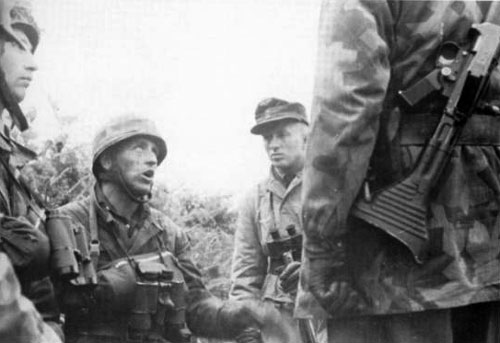
Towards the end of 1943, Hitler had approved a plan proposed by Göring to rapidly expand the size of the Fallschirmtruppen.
Up until this point in time the German Airborne forces consisted of 2 Parachute Divisions (1. and 2. Fallschirmjägerdivision) which had formed the XI Flieger Korps. Under Göring’s ambitious scheme, these two units would provide cadres to form two more airborne division, the 3. and 4. Fallschirmjägerdivisions.
The 1st and 4th Airborne Divisions would together become I. Fallschirm-Korps (I Parachute Corps) while the 2nd and 3rd Divisions would constitute II. Fallschirm-Korps (II Parachute Corps), two parachute armies with an anticipated strength of 100,000 first rate soldiers, equal in status to Himmler’s Waffen SS units in recruiting, weaponry and training. 5. Fallschirmjägerdivision was then formed in March 1944 and also joined II. Fallschirm-Korps.
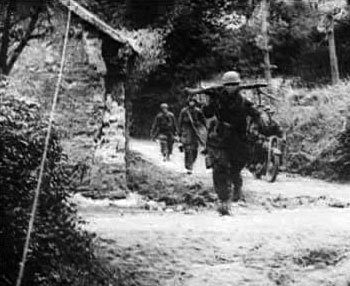
• 2. Fallschirmjägerdivision (refitting in Koln-Wahn, Germany after recently returning from the Eastern Front – soon to be headquartered in Brest, France);
• 3. Fallschirmjägerdivision (headquarters at Huelgoal, Brittany);
• 5. Fallschirmjägerdivision (headquarters at Rennes, Brittany); and
• 6. Fallschirmjägerregiment (formally a regiment of 2. Fallschirmjägerdivision, but attached to II. Fallschirm-Korpsand based in the Lessay-Monte Castre-Carentan area)
By D-Day, Göring’s grand plan to rival the Waffen-SS was far from reality. Some units of the II. Fallschirm-Korps such as the 6. Fallschirmjägerregiment and 3. Fallschirmjägerdivision were generally well equipped and had excellent personnel.
Together they could easily be considered the most competent infantry units at von Rundstedt’s disposal and they fought with distinction throughout the campaign.
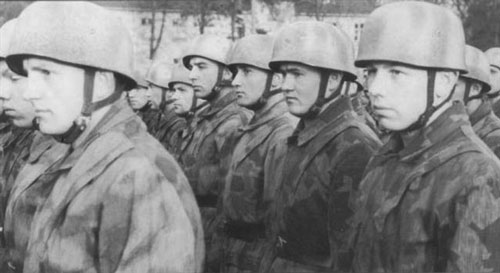
6. Fallschirmjägerregiment
In October 1943, as part of the general expansion of the Fallschirmtruppen, 6. Fallschirmjägerregiment was transferred from 2. Fallschirmjägerdivision to 3. Fallschirmjägerdivision, where it was split into various cadres and deactivated.
In November 1943 the Regiment was activated again and began to reorganise in January 1944 with the goal of having the training and equipping of its troops completed within four months. As 2. Fallschirmjägerdivision was in action on the Eastern Front, 6. Fallschirmjägerregiment was subordinated directly to the Fallschirmjäger Armee.
The Regiment was organised along the same lines as a standard German Army Infantry Regiment, having three battalions, each of which was made up of three rifle companies and a heavy company. The 13th Company was a heavy mortar company, the 14th an anti-tank company and the 15th an engineer company. As of 6 June 1944

6. Fallschirmjägerregiment
– Commander: Major von der Heydte
– Adjutant: Hauptmann Peiser
I. Bataillion
– Commander : Hauptmann Emil Priekschat
– Adj: Oberleutnant Reese
– 1. Kompanie (Rifle): Oberleutnant Billion
– 2. Kompanie (Rifle): Oberleutnant Schulz
– 3. Kompanie (Rifle): Hauptmann Bucher
– 4. Kompanie (Heavy): Leutnant Scherer
II. Bataillion
– Commander: Major Rolf Mager
– Adj: Hauptmann Schulte
– 5. Kompanie (Rifle): Hauptmann Herrmann
– 6. Kompanie (Rifle): Leutnant Bruunklaus
– 7. Kompanie (Rifle): Leutnant von Socha-Borzestowski
– 8. Kompanie (Heavy): Oberleutnant Graf Bethusy-Huc
III. Bataillion
– Commander: Hauptmann Horst Trebes
– Adj: Leutnant Treuherz
– 9. Kompanie (Rifle): Oberlautnant Wagner
– 10. Kompanie (Rifle): Oberleutnant Prive
– 11. Kompanie (Rifle): Oberleutnant Märk
– 12. Kompanie (Heavy): Oberleutnant Pöppel
– 13. Schwere GrW.Kompanie (Heavy Mortar): Oberleutnant Nahde
– 14. Panzerjägerkompanie (Anti-tank): Leutnant Geck
– 15. Pionerekompanie (Engineer): Hauptmann Hauch
The total fighting strength of 6. Fallschirmjägerregiment at this time was 3,457 officers and men. This was considerably larger than an equivalent Army unit and the rifle companies of the Regiment had twice as many light machine-guns as a standard Infantry Division’s companies. The men were also of a higher quality compared with many of the other more standard units at this time. At least a third of the officers and a good portion of the non-commissioned officers were veterans, having fought in Crete, North Africa and Russia. The remainder of the men were all volunteers, with the average age across the Regiment being 17 ½ years. Morale was excellent and interestingly enough the whole Regiment was jump trained, each man having made six day-time and three night-time jumps.
The main weakness of the 6. Fallschirmjägerregiment was the same as all of the regiments and divisions of von Rundstedt’s army – they simply lacked any real transport capability. Each company in the Regiment had an average of two trucks, and the seventy trucks across the whole unit were of fifty different makes – German, French, Italian and even British.
In May 1944 the Regiment was deployed to Normandy and spread out amongst the towns at the base of the Cotentin peninsula. These were Lessay, Periers, Raids, St Georges-de-Bohon, Meautis, Baupe and Monte Castre. It was assigned to LXXXIV Corps and for supply purposes attached to 91. Luftlandedivision, an air-landing division. Together they formed the strategic reserve for the Corps.
D-Day
From the first moments of the airborne invasion of France 6. Fallschirmjägerregiment was in action against American paratroopers from the US 101st Airborne Division. Scattered fire-fights continued throughout the night, until about 0600 on 6 June the Regiment was given orders to assemble and clear the region between Carentan and St. Mere-Eglise of enemy troops. It was no easy task to withdraw troops currently spread out, in action and with limited transport and get them to the assembly point so it took until early afternoon for the initial movement and reorganisation to be completed.
The troops then moved through Carentan which Major von der Heydte had already determined was not occupied by American troops. 3. Bataillion initially remained behind in the town with the 13th Company, protecting the Regiment’s rear areas, while the regimental command post was set up at St. Come du Mont. 1. Bataillion moved out towards St. Marie-du-Mont while 2. Bataillion advanced on St. Mere-Eglise.

2. Bataillion successfully withdrew and attempted to link up with the now surrounded 1. Bataillion but was unable to move more than a few hundred yards east of St. Come du Mont. By now 1. Bataillion was trying to extricate itself to the south. While crossing through open fields and marshes north of the Douve River it came under fire from small groups of the 501st and 506th Parachute Infantry Regiments (PIR). The American troops were able to bluff the 1. Bataillion into believing they were facing overwhelming US strength and the majority of the battalion surrendered, with only 25 men escaping to Carentan.
Other elements of the 506th PIR, supported by 6 Sherman tanks of the 746th Tank Battalion and the guns of the 65th Armoured Field Artillery Battalion, advanced on St. Come du Mont which von der Heydte had now protected with 2 battalions of his own troops. While the US paratroopers made headway, they could not dig the Jäger out from their defences amongst the solid Norman hedgerows. The attack was called off so a much larger assault could be launched the following day.
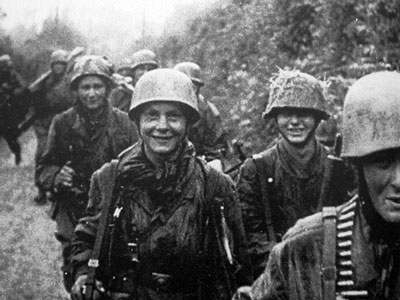
The Glider Infantry and 501st PIR attempted to encircle the town and cut off the German’s retreat, while the units of the 506th PIR advanced directly into St. Come du Mont. An intense artillery barrage (2500 105mm rounds in the first 1 ½ hours) smashed into the defenders and as the 1058. Grenadiers started to show signs of cracking, von der Heydte decided that with no more reserves to commit, it was time to withdraw. His men were forced to fight their way past the 501st PIR, but the majority of the German forces were able to escape to the west and retreat back into Carentan.
Carentan
The Americans immediately began to prepare an assault on Carentan, readying four regiments (501st, 502nd and 506th PIR and 327th Glider Infantry) for the attack A two pronged attack down the main causeway in Carentan (502nd) and across the river flats to the east of the city (327th) was put into action. The causeway was a six to nine feet high embankment above the marshland with four bridges that crossed the Douve and its associated canals. The German defenders had destroyed one of the bridges.
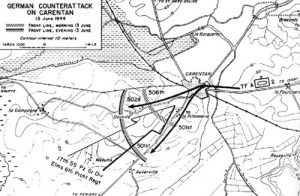
On the morning of 11 June, an intense artillery barrage was arranged to force the Jäger out of the farmhouse. This failed, and it wasn’t until the US Battalion Commander personally led a dramatic charge against the position that the German paratrooper’s rifle pits and machine-gun posts in front of the building and along the hedgerows were knocked out. Three American battalions had been used in the action thus far and this attack had finally exhausted 502nd PIR meaning the 506th PIR would have to take over the advance.
327th Glider Infantry had also slowly made headway and by the morning of 11 June they were just a few hundred yards from the eastern outskirts of Carentan, where they were finally stopped by German fire.
By now von der Heydte’s men were running seriously short of ammunition. Supplies had not been able to come forward due to the shortage of motor transport and the Allied air forces interdiction of the Normandy road network.
This had also held up any reinforcements that were trying to reach Carentan. The only resupply came during the night of 11/12 June when ammunition was air dropped to the Fallschirmjäger southwest of the city.
On the evening of 11 June 501st and 506th PIR were committed to the battle and throughout the night the US paratroopers watched as Carentan was subjected to near continual naval gun fire, artillery, mortar and tank destroyer bombardment. At 0200 hours on 12 June 506th attacked Hill 30 to south of the city and from there, at 0500 hours they assaulted the city. From the northeast 327th Glider Infantry also drove into Carentan, with the two units meeting up at 0730. 501st PIR circled the city, linking up with 506th PIR, closing the trap around German defenders. Remarkably, the German defenders seemed to offer little resistance.
Unbeknownst to the Americans, von der Heydte had recognised the danger and before dark on 11 June had withdrawn from Carentan and set up a new defensive line to the southwest of the city. This line held against the attacks by 501st and 506th PIR that resumed on the afternoon of 12 June.
On 12 June the reinforcements that were meant to assist 6. Fallschirmjägerregiment in holding Carentan finally arrived, the 17. ‘Gotz von Berlichingen’ SS-Panzergrenadierdivision. Annoyed that Fallschirmjäger had given up the city, Brigadeführer Ostendorff, the SS Commander, at first sought von der Heydte’s arrest for defeatism, but was eventually calmed down by his superiors. The Jäger were now subordinated to the SS Division and on 13 June, together they launched a counter attack to regain Carentan.
The attack, supported by assault guns from 17. SS-Panzerabteilung hit both 501st and 506th PIR at 0630 and drove them back towards the city. II. Bataillon, 6. Fallschirmjägerregiment managed to get into Carentan and took up positions near the railway station, however they were forced to retreat when 502nd PIR and a combat group made up of a battalion of tanks and a battalion of armoured infantry from 2nd Armoured Division and supported by the 14th Armoured Field Artillery Battalion were committed to the battle. By the early afternoon the initiative had swung back to the Americans and the attack was repulsed. This was the last time German forces attempted to retake Carentan.
The next few weeks saw less activity in this sector of the battlefield as the American units there passed over to the defensive while the main US operations shifted to the taking of Cherbourg. The Americans around Carentan sought to consolidate their gains and bring in reinforcements. The 6. Fallschirmjägerregiment remained active, patrolling and probing the US defences, whilst constantly preparing their own defences with bunkers, mines and barbed wire.
St. Germain-sur-Seves
Mid July found 6. Fallschirmjägerregiment entrenched around the village of St. Germain-sur-Seves on a small ‘island’ bordered by the Seves River, marshland and creeks. All of this area was heavy bocage country. Opposing them was the US 90th Infantry Division, a unit that had fought hard and suffered heavy casualties thus far in the campaign and who was now largely made up of green replacements. The 90th had been tasked with taking St. Germain-sur-Seves as a prelude to the main attack on St. Lo.
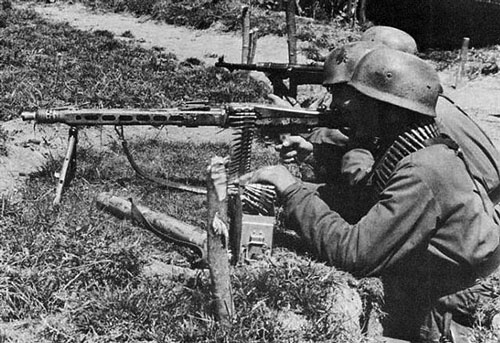
Major von der Heydte had incorrectly assumed that the American attack was a small reconnaissance in force and that Uhlig’s company of 32 men would be enough to successfully complete the mission.
However, after a brief survey of the battlefield Uhlig realised his unit would be facing at least 300 US soldiers. Seemingly unconcerned by this disparity at 1800 he launched his attack into the right flank of the 358th 1st battalion and over the next three hours his men drove the Americans back 350 yards. Four Jäger were lost in the attack, but as Uhlig had been unable to take any prisoners he decided to continue.
As he listened to the US infantry digging in overnight, Uhlig decided that he would need to launch his next attack from the other flank to achieve surprise. He then went looking for reinforcements and was promised 2 MG42 heavy machine-guns and 16 men from 3. Bataillon. He also found a tank commander from the 2. ‘Das Reich’ SS-Panzerdivision who arranged for 3 panzers to support the attack the next morning.
Uhlig positioned the MG 42s to stop any reinforcements from reaching the American’s forward positions, and also to block the unit he would be attacking from retreating back to the US main lines. The machine-gunners were ordered not to fire in support of the initial assault, keeping their presence as a surprise.
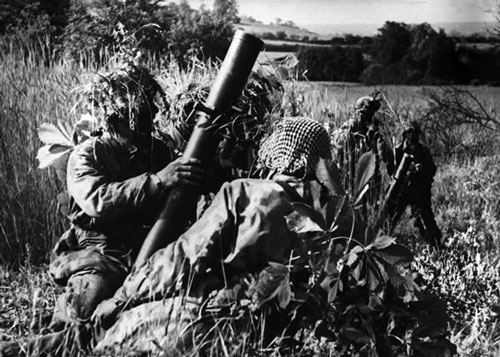
Uhlig’s company of 50 men and one panzer had captured over 200 American soldiers through the effective use of his limited resources, terrain, close armour support, well-positioned machine guns and their cumulative effect on a green battalion.
Immediately after the battle, the Jäger witnessed several US Army chaplins trying to help the wounded men in no-man’s land. Impressed by their bravery an impromptu ceasefire began, later formalised by von der Heydte into a three hour truce which also allowed an exchange of wounded prisoners.
On 24 October 1944 Alexander Uhlig was awarded the Knight’s Cross for his actions near St. Germain-sur-Seves in July. He would later be captured by members of the 90th Infantry Division and survive the war.
Cobra
6. Fallschirmjägerregiment was still operating with 2. ‘Das Reich’ SS-Panzerdivision when American forces launched Operation Cobra. The regiment, together with the SS troops were forced to break out of the Roncey Pocket in the final days of July 1944.
Days later 6. Fallschirmjägerregiment was again almost surrounded in the Villedieu pocket, but acting on his own initiative von der Heydte led his Regiment out of the trap.
On 31 July what remained of 6. Fallschirmjägerregiment was attached to 353. Infanteriedivision. Formed into a small kampfguruppe the Jäger made up the infantry division’s reserve and were moved to wherever the action was thickest or a penetration in the German main line of resistance most likely.
On 10 August the 6. Fallschirmjägerregiment was ordered to disengage and move to Nancy in Northeastern France for refitting.
The 6. Fallschirmjägerregiment suffered approximately 3000 casualties during the Normandy Campaign.

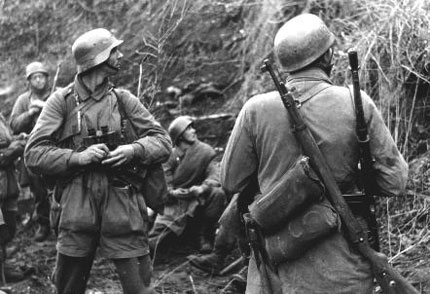
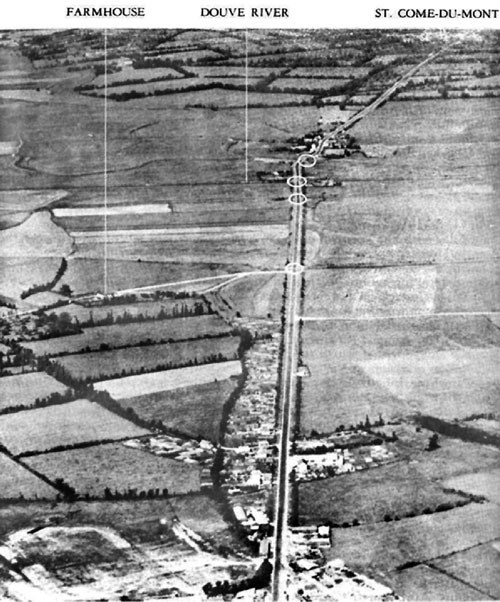
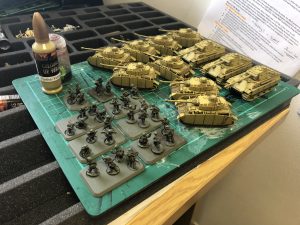 I started as I always do with writing my ideal list, regardless of points, for the units I have seen in the book that I want in my army. This time, it was the turn of copious amounts of Panzer IV, Panthers, and troops to enter the fray and get my appetite whet. One thing to bear in mind with the German Book for D-Day is that there are a lot of options for units. The first thing a player will notice is, similar to Fortress Europe, you can take multiple tank formations of Tigers and the bigger tanks that the Germans employed in the later stages of 1944.
I started as I always do with writing my ideal list, regardless of points, for the units I have seen in the book that I want in my army. This time, it was the turn of copious amounts of Panzer IV, Panthers, and troops to enter the fray and get my appetite whet. One thing to bear in mind with the German Book for D-Day is that there are a lot of options for units. The first thing a player will notice is, similar to Fortress Europe, you can take multiple tank formations of Tigers and the bigger tanks that the Germans employed in the later stages of 1944.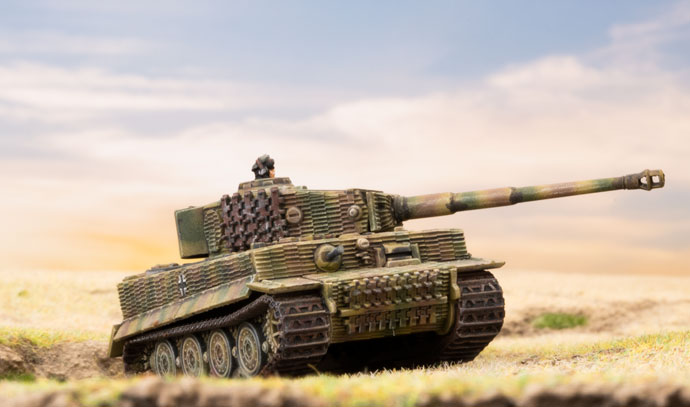 This poses an issue as to take lots of tanks, costs lots of points. Hence my decision to go with Panzer IV, that ubiquitous workhorse of the Heer, in quantity with some elite tanks attached. Hello Panthers! The tracks, the guns, the turrets… I knew I had to take some Panthers to show the American 76mm who was boss of the battlefield. Now with the German D-Day book there is another variant of the Panther – The Panther A.
This poses an issue as to take lots of tanks, costs lots of points. Hence my decision to go with Panzer IV, that ubiquitous workhorse of the Heer, in quantity with some elite tanks attached. Hello Panthers! The tracks, the guns, the turrets… I knew I had to take some Panthers to show the American 76mm who was boss of the battlefield. Now with the German D-Day book there is another variant of the Panther – The Panther A.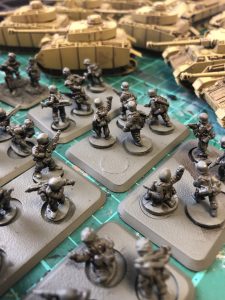 Time is money and having already committed to building a 100pt army of US Paras, with their lovely high model count, for the UK Office Hobby League, I wanted as few stands and tanks to paint as possible. Then it was time to trim the list. First out were extra Panzers and Panthers to maintain an equilibrium in points so as to make sure any one formation wasn’t too high, but also so I could squeeze in a second formation of troops to hold and contest objectives, and be a pivot for my tanks to run off. I eventually managed to come up with this list:
Time is money and having already committed to building a 100pt army of US Paras, with their lovely high model count, for the UK Office Hobby League, I wanted as few stands and tanks to paint as possible. Then it was time to trim the list. First out were extra Panzers and Panthers to maintain an equilibrium in points so as to make sure any one formation wasn’t too high, but also so I could squeeze in a second formation of troops to hold and contest objectives, and be a pivot for my tanks to run off. I eventually managed to come up with this list: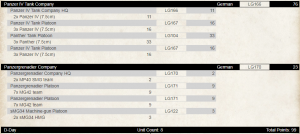
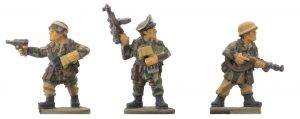
 First I primed the figures with a black rattle can. Then to speed things up I airbrushed the figures Khaki. This gave me a light base colour to work over rather than trying to paint beige / tan over the black primer. It also meant I could drybrush on the German Camo Beige for the smocks to create initial shading. Then I simply block painted all the items, trying to be as neat as possible.
First I primed the figures with a black rattle can. Then to speed things up I airbrushed the figures Khaki. This gave me a light base colour to work over rather than trying to paint beige / tan over the black primer. It also meant I could drybrush on the German Camo Beige for the smocks to create initial shading. Then I simply block painted all the items, trying to be as neat as possible.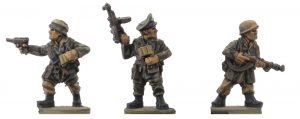
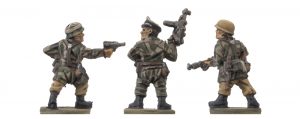


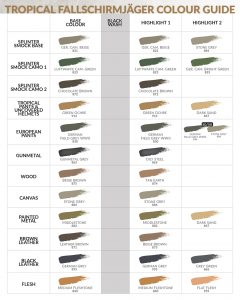


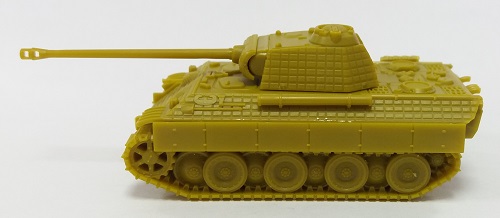
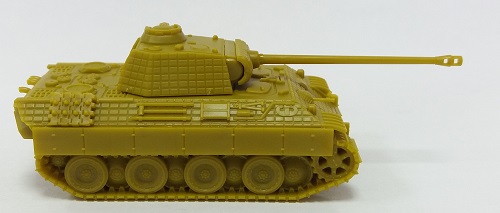
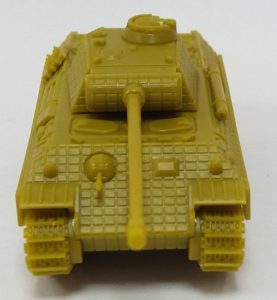
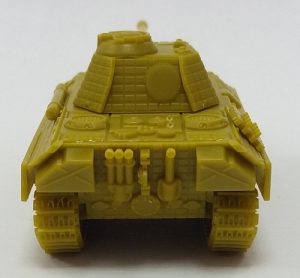
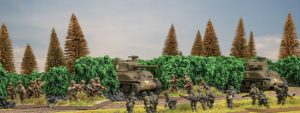 I love the Armored Rifle Company but I just don’t have the time to paint that many infantry up fast enough for our league, having let my “paint figure quickly” skill atrophy over time. I don’t relish being hit on a 3+ so my plan is for a complete Veteran M4 Sherman Tank Company.
I love the Armored Rifle Company but I just don’t have the time to paint that many infantry up fast enough for our league, having let my “paint figure quickly” skill atrophy over time. I don’t relish being hit on a 3+ so my plan is for a complete Veteran M4 Sherman Tank Company.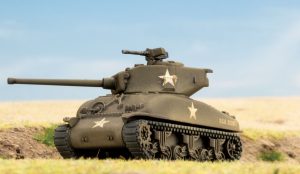 My 76mm tanks are going to be the biggest threat to any German armor I encounter and are thus, the most likely targets of enemy counter fire. That being said, all of the smoke that I can lay down with the 75mm and 105mm Sherman Tanks should be sufficient to protect my boys from too much steel coming their way and hitting them until they get into range.
My 76mm tanks are going to be the biggest threat to any German armor I encounter and are thus, the most likely targets of enemy counter fire. That being said, all of the smoke that I can lay down with the 75mm and 105mm Sherman Tanks should be sufficient to protect my boys from too much steel coming their way and hitting them until they get into range.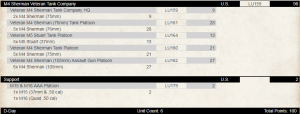
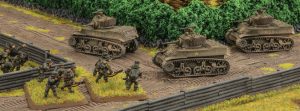 The standard 75mm Sherman Tanks, when they’re not casting smoke down-range, are more than sufficient in knocking out Panzer IVs but really need the flank shots to have a hope of pinging any Panthers or Tigers; they’ll be operating mostly in support of the 76mms unless I see an opening I can exploit.
The standard 75mm Sherman Tanks, when they’re not casting smoke down-range, are more than sufficient in knocking out Panzer IVs but really need the flank shots to have a hope of pinging any Panthers or Tigers; they’ll be operating mostly in support of the 76mms unless I see an opening I can exploit.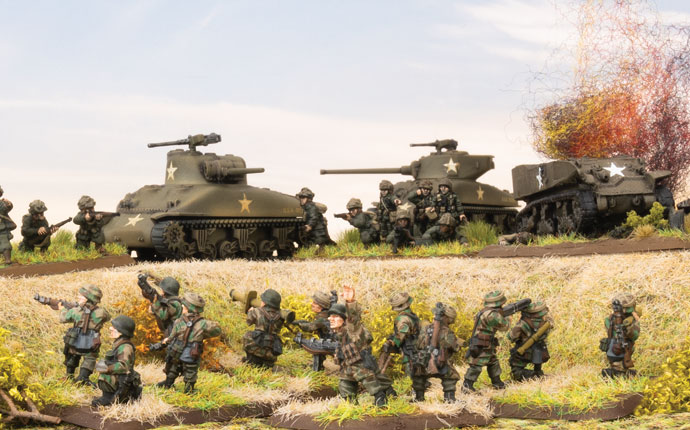 Lastly, just in case someone brings some aircraft, I’ve got a small contingent of AAA to handle that eventuality.
Lastly, just in case someone brings some aircraft, I’ve got a small contingent of AAA to handle that eventuality. A tabletop approximation of 16. Feld-Division (L) in Normandy, 1944, offers me both of these chances— an opportunity to paint Luftwaffe blue, and an opportunity to modify a few grenadier uniforms to reflect the very swish LwFD camouflage smock.
A tabletop approximation of 16. Feld-Division (L) in Normandy, 1944, offers me both of these chances— an opportunity to paint Luftwaffe blue, and an opportunity to modify a few grenadier uniforms to reflect the very swish LwFD camouflage smock.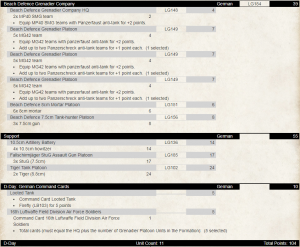
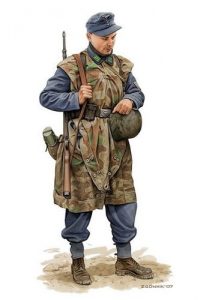 Project Research
Project Research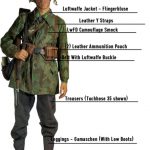
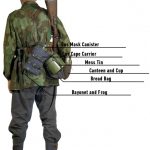
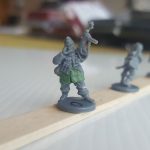
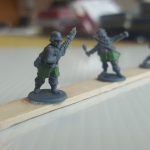


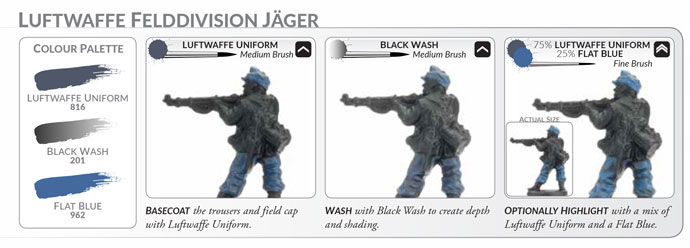
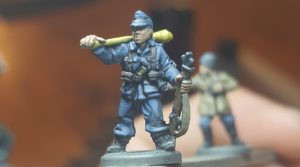 The Rest of the Stuff in the List
The Rest of the Stuff in the List
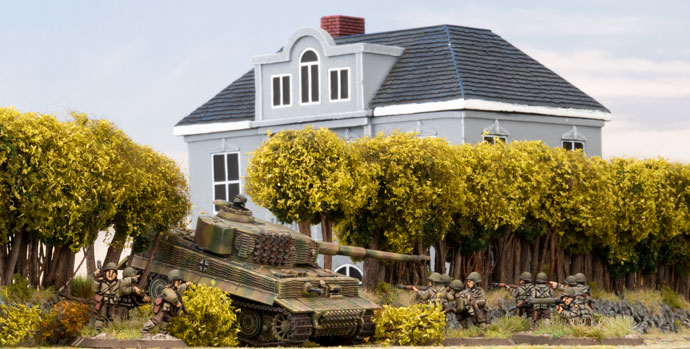
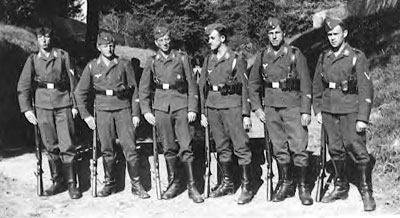 In the desperate winter of 1941, the Heer, the German Army, was on the defensive after its failed advance on Moscow. Every available unit was thrown into the battle, including the Luftwaffe Fallschirmjäger (air force paratroops). One such unit was the Luftlandesturmregiment, Air-landing Assault Regiment, under Generalmajor Meindl. The regiment’s casualties were so severe that it was withdrawn early in 1942.
In the desperate winter of 1941, the Heer, the German Army, was on the defensive after its failed advance on Moscow. Every available unit was thrown into the battle, including the Luftwaffe Fallschirmjäger (air force paratroops). One such unit was the Luftlandesturmregiment, Air-landing Assault Regiment, under Generalmajor Meindl. The regiment’s casualties were so severe that it was withdrawn early in 1942.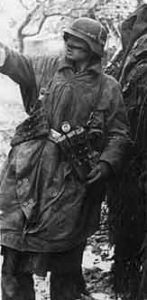 By the spring of 1942, the Army’s need for troops to replace its casualties was so acute that they convinced Hitler to transfer surplus troops from the Luftwaffe to the Heer. Reichsmarshall Herman Göring, Commander In Chief of the Air Force, was furious. Not only would his personal empire be diminished, but also the reactionary Army, the very organisation responsible for the failures of the previous year, would corrupt his loyal National Socialist airmen.
By the spring of 1942, the Army’s need for troops to replace its casualties was so acute that they convinced Hitler to transfer surplus troops from the Luftwaffe to the Heer. Reichsmarshall Herman Göring, Commander In Chief of the Air Force, was furious. Not only would his personal empire be diminished, but also the reactionary Army, the very organisation responsible for the failures of the previous year, would corrupt his loyal National Socialist airmen.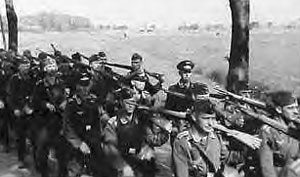 Luftwaffe field divisions were approximately half the size of their Heer counterparts.
Luftwaffe field divisions were approximately half the size of their Heer counterparts.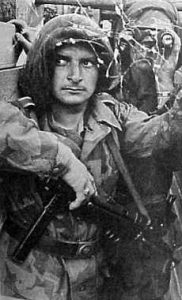 2. Luftwaffe Felddivision (Oberst Hellmuth Pätzold)
2. Luftwaffe Felddivision (Oberst Hellmuth Pätzold)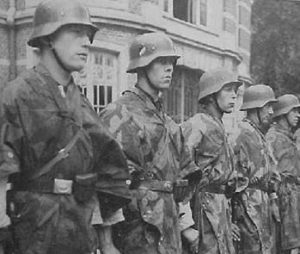 4. Luftwaffe Felddivision (Oberst Hans-Georg Schreder)
4. Luftwaffe Felddivision (Oberst Hans-Georg Schreder) 7. Luftwaffe Felddivision (Generalmajor Wolf Freiherr Von Biedermann)
7. Luftwaffe Felddivision (Generalmajor Wolf Freiherr Von Biedermann) 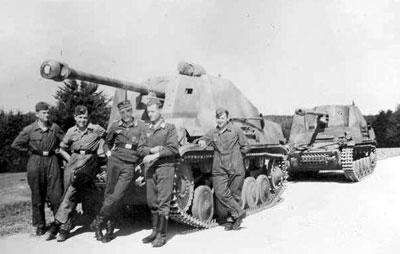
 10. Luftwaffe Felddivision (Generalmajor Walter Wadhehn)
10. Luftwaffe Felddivision (Generalmajor Walter Wadhehn)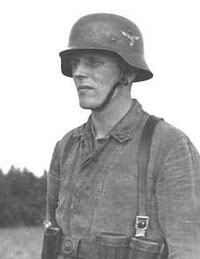 11. Luftwaffe Felddivision
11. Luftwaffe Felddivision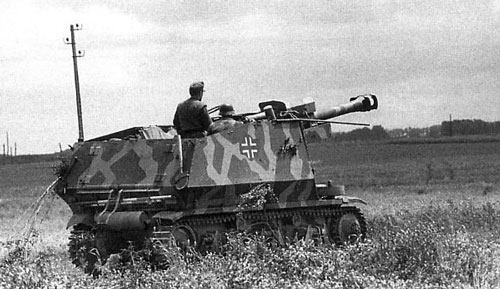 17. Luftwaffe Felddivision
17. Luftwaffe Felddivision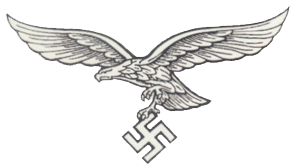 Between then and December 1942, when 21. Luftwaffe Felddivision was formed, the division was reunited and held the southern flank of the newly opened corridor to Demyansk and Cholm. The newly formed division only had four regiments, the fifth having been disbanded. It gained an artillery regiment with French guns in the summer of 1943, along with an assault gun battery of four long-barrelled StuG III assault guns (increased by a further six StuG IV in 1944) and ten 7.5cm PaK40 guns. Each regiment was also reported as having as many as ten 7.62cm PaK36(r) anti-tank guns. At this point it was easily the strongest Luftwaffe field division in existence.
Between then and December 1942, when 21. Luftwaffe Felddivision was formed, the division was reunited and held the southern flank of the newly opened corridor to Demyansk and Cholm. The newly formed division only had four regiments, the fifth having been disbanded. It gained an artillery regiment with French guns in the summer of 1943, along with an assault gun battery of four long-barrelled StuG III assault guns (increased by a further six StuG IV in 1944) and ten 7.5cm PaK40 guns. Each regiment was also reported as having as many as ten 7.62cm PaK36(r) anti-tank guns. At this point it was easily the strongest Luftwaffe field division in existence. The division was involved in heavy fighting from March 1944 until it surrendered in the Courland pocket at the end of the war.
The division was involved in heavy fighting from March 1944 until it surrendered in the Courland pocket at the end of the war.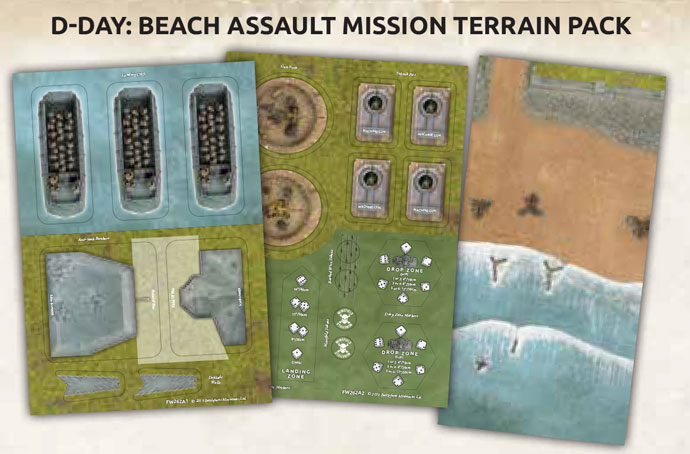 Focussing on D-Day with the first wave of Late War releases has given us all a chance to get excited about the monumental D-Day landings and airborne assaults vividly brought to life by media like
Focussing on D-Day with the first wave of Late War releases has given us all a chance to get excited about the monumental D-Day landings and airborne assaults vividly brought to life by media like 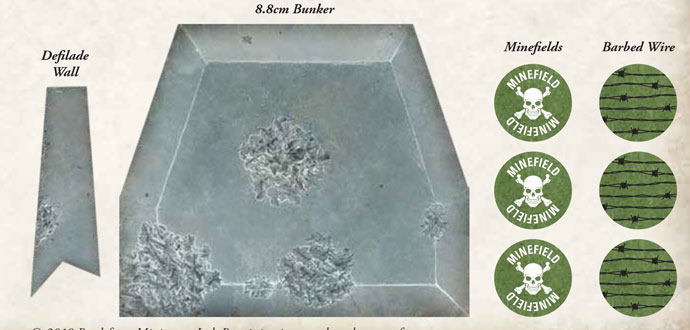
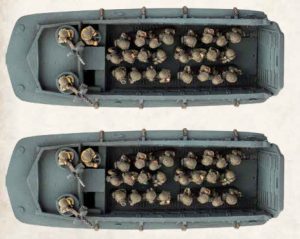
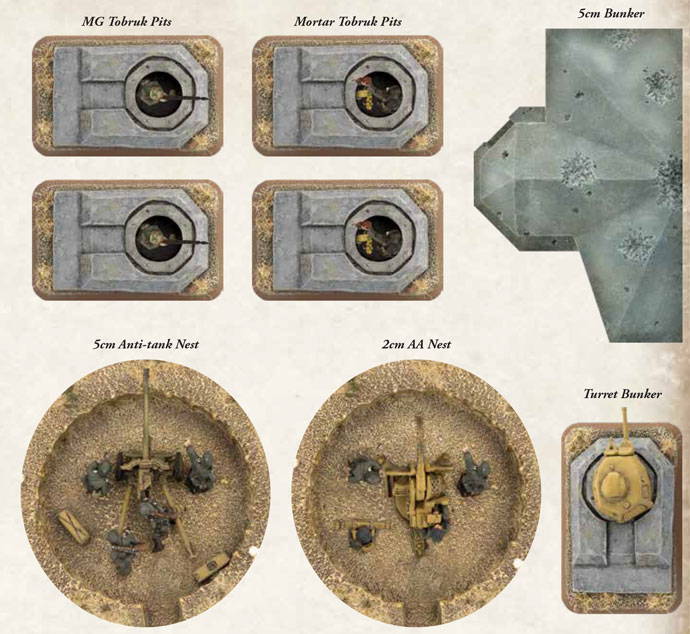
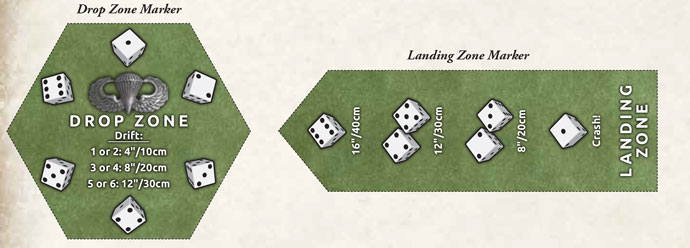 You can check out our handy How-To videos on Airborne and Beach Landings below- everything you need to know to use the new Cardboard Terrain pack!
You can check out our handy How-To videos on Airborne and Beach Landings below- everything you need to know to use the new Cardboard Terrain pack! With everyone in the Big Four selecting one of the four major Flames Of War Late War forces, it fell to Wayne to work on a German force which you can check out here on the
With everyone in the Big Four selecting one of the four major Flames Of War Late War forces, it fell to Wayne to work on a German force which you can check out here on the 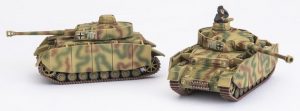

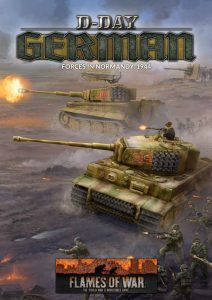 You can read a collection of community content ranging from reviews to force overviews, battle reports to Command Card forces from the great Flames Of War community.
You can read a collection of community content ranging from reviews to force overviews, battle reports to Command Card forces from the great Flames Of War community.